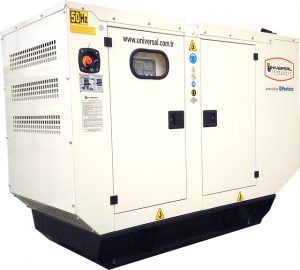
Generators
Having a conventional generator for OffGrid living is important. You will need it to keep stuff running when there is maintenance on your power system, when ever you need power further away than your cable reaches. It can be important backup for times when solar power production is low. Combined with a battery charger (or a grid input connection on the inverter), it is an easy way to refresh your batteries. If sized properly, your battery charger should charge the battery within around 3 hours. It is recommended to have at least one generator with some 2 days load of fuel ready and in good shape for emergency power situations.
Generator types
Diesel
Expensive, fuel efficient, cheap fuel, can be build into multi fuel and generally available with big power outputs up to 25Kw and more.
Most other power tools that run with an engine will use gasoline, so you need to have an extra tank for diesel and not mix them up somehow.

Gasoline
Most popular generators. Cheap, broadly available, easy to obtain fuel, can be adapted to run on gas, and very portable. Common models range from 750Watt to 4.5Kw. Recommended to have one of these.

Gas, Biogas
A bit more expensive then gasoline generators. Biogas can be produced on site. Downside is that gas is more explosive then liquid fuel.
Most conventional gasoline generators can be converted to also run on butan, oktan or biogas. Read more on biogas..

Unconventional generator types
Stirling engine
A Stirling engine can be converted to produce electricity if you are half decent with mechanics. Simply put it is a steam powered generator that has a closed circuit for the water/steam. If you are more interested in stirling engines start with this -> https://en.wikipedia.org/wiki/Stirling_engine

Wood Gas Generator
A wood gas generator is a gasification unit which converts timber or charcoal into wood gas, which – after cooling and filtering – can then be used to power an internal combustion engine or for other purposes. Historically wood gas generators were often mounted on vehicles, but present studies and developments concentrate mostly on stationary plants.
Read more on Wood Gas Generators..

Thermoelectric Generator- TEG
A thermoelectric generator is a solid state device that converts heat, or in better terms temperature differences, into electrical energy. They utilise the Seebeck effect to generate electricity. Thermoelectric generators can be designed to be completely silent. They have a very high initial cost per watt of electrical power output. There is a decent amount of thermoelectric generator module manufacturing knowledge. However, a disadvantage is, the design and engineering expertise required. This Inhibits wider adoption due to applications that result in lower efficiency and high cost. To put it simple, very expensive for little power output.

PedalGenerator- BikeGenerator
A healthy way to generate energy can be pedal powerd generators. While not sustainable, it is a real option to get energy into your batteries. A normal human, depending on fitness ofcourse, can generate around 100 to 250Watt energy that way. It is possible to have such a generator as stand for your normal bike, altho that is not the most efficient option. More specialized pedal generators include a flywheel in the construction as well as other modifications. There is plenty of DIY plans for all types of bikes and construction types available in your favorite search engine.
—
Photo Credit: Christina Woodward
